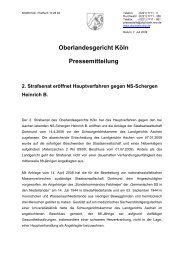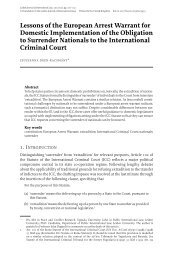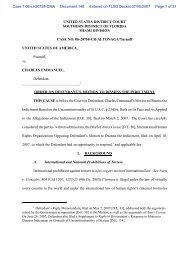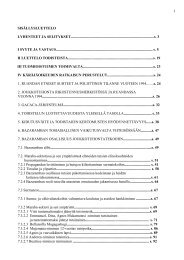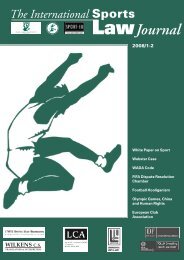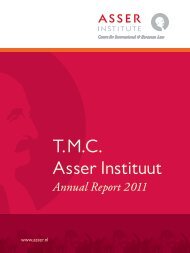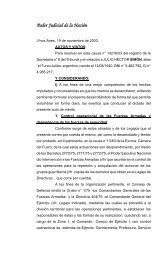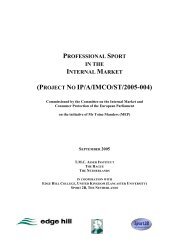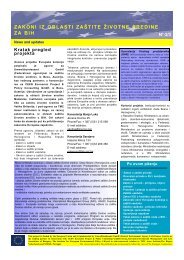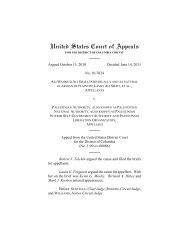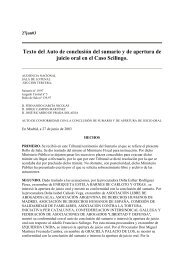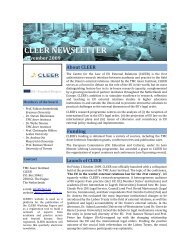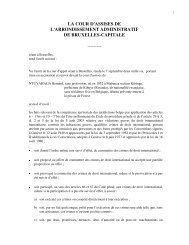Islj 2009 3-4 - TMC Asser Instituut
Islj 2009 3-4 - TMC Asser Instituut
Islj 2009 3-4 - TMC Asser Instituut
You also want an ePaper? Increase the reach of your titles
YUMPU automatically turns print PDFs into web optimized ePapers that Google loves.
or serious bodily harm. Such preparation can be evidenced by internetcommunications,<br />
phone conversations, etc. The goal of this third pillar<br />
is to enable the authorities to respond to the threat of disorder in<br />
an earlier stadium. For example, if the police intercept a communication<br />
on an internet message board between two groups of hooligans,<br />
setting a time and place for a fight in a field somewhere, within the<br />
current array of measures the police can only respond once an actual<br />
fight breaks out. Under the new proposal, the person posting the message<br />
could be prosecuted, without an actual fight breaking out.<br />
The Football Law<br />
The proposed Football Law was initiated on May 20, 2008 by the<br />
Ministry of Domestic Affairs and the Ministry of Justice. On April 7,<br />
<strong>2009</strong>, the proposed Football Law was approved by the Second Chamber<br />
of Parliament with an overwhelming majority. The Second Chamber<br />
made a number of far reaching amendments to the Football Law.<br />
In the Netherlands, for a law to take effect, a couple steps have to<br />
be taken. Most laws are initiated by the government, due to the complexity<br />
of most laws and the resources of the Ministry. After a law is<br />
initiated, advice regarding the law is asked of the Council of State.<br />
Following this advice, the law is sent to the Second chamber of<br />
Parliament. The Second Chamber can make amendments to the proposed<br />
law. The Second Chamber then holds a public vote on the proposed<br />
law. After the Second Chamber has approved a proposed law,<br />
the proposal is sent to the First Chamber. The First Chamber cannot<br />
make amendments to any legislative proposals. The First Chamber<br />
discusses the proposed law and then votes on the proposal. A simple<br />
majority of the votes suffices for the proposal to pass in the First<br />
Chamber. If questions arise concerning a proposal in the First<br />
Chamber, the vote can be held off for a period of time. However, the<br />
First Chamber has no right of amendment and can therefore not<br />
make changes to any proposed legislation itself. After the First<br />
Chamber approves proposed legislation, the law can take effect after<br />
it is signed by the Queen of the Netherlands.<br />
The actual proposal for the Football Law, as it stands now, was initiated<br />
by the Ministry of Domestic Affairs and the Ministry of Justice,<br />
even though the first steps to come to such a law were taken by a number<br />
of parliamentarians. The Football Law, after the Council of State’s<br />
advisory opinion was received and attached to it, was sent to the<br />
Second Chamber of Parliament. The Second Chamber discussed the<br />
Football Law and made some (important) amendments to the proposal.<br />
The Football Law was then voted on and with an overwhelming<br />
majority approved by the Second Chamber. The Second Chamber<br />
then sent the Football Law to the First Chamber, where it is currently<br />
being discussed and awaits the vote in the First Chamber. However,<br />
given the overwhelming majority the proposal received in the vote in<br />
the Second Chamber, it is to be expected that the proposal will also<br />
pass the vote in the First Chamber. The Football Law, if passed in the<br />
First Chamber, could enter into force before the end of <strong>2009</strong>.<br />
The Football Law has been included in a broader proposed law to<br />
counteract public disorder. The law is, in a broad sense, supposed to<br />
counteract all sorts of different structural nuisances. This law specifically<br />
targets violations of public order by groups of people (for example<br />
youths or football supporters), who through their often times<br />
criminal behavior, create an unsafe environment in the areas or neighborhoods<br />
where they hang around. The current legal array of measures<br />
in the Netherlands, according to the drafters of the proposed law,<br />
does not suffice to deal with this problem. The problem with the<br />
behavior of such groups currently is that the police have to wait until<br />
an actual criminal act happens until they can deal with this group. A<br />
further problem in such a case is that the police have to be able to pinpoint<br />
the crime to a specific, individual perpetrator. And even if the<br />
police are able to pinpoint a criminal act to a certain person and punish<br />
that person for that act, they might still not actually be doing anything<br />
about the overall unsafe environment created by the group.<br />
Such a group in a lot of cases consist of leaders and followers. To really<br />
deal with the problems caused by a certain group, the police will<br />
need to deal with these leaders. However, these leaders will often<br />
times not engage in any criminal acts directly, but direct their followers<br />
into doing these acts. Under the current array of legal measures, it<br />
is therefore very difficult for the authorities to directly take measures<br />
against such a group that causes disorder and their leaders.<br />
The behavior that is specifically targeted by this law is structural<br />
and often times criminal behavior through which public order is violated.<br />
Specific examples of such behavior are intimidation, threatening<br />
behavior and vandalism. The person targeted by this law engages<br />
in such behavior individually or within the group he or she forms a<br />
part of. However, there has to be a pattern of possibly criminal behavior<br />
that structurally violates public order.<br />
Even though this law targets offences against public disorder in a<br />
broader sense, one of the specific aims of this law is to deal with the<br />
problem of football hooliganism. This law is specifically intended to<br />
provide a zero tolerance policy for the small core group of hooligans<br />
that structurally misbehaves around football matches. According to a<br />
number of surveys studied in preparation for this law, hooligan<br />
groups are loosely structured groups with a dynamic membership.<br />
However, these surveys also show that at the core of these hooligan<br />
groups are a small number of people, who have been members of the<br />
group for a while and who have clear, hierarchical roles within the<br />
group. It is these hooligans, who are at the core of their respective<br />
groups and who are able to direct the behavior of the group, which<br />
this law specifically intends to target.<br />
In the current array of measures, there are some possibilities for the<br />
mayor to respond to the behavior targeted. However, these measures<br />
are more designed to respond to immediate outbreaks that violate<br />
public order, rather than the structural violations against public order<br />
targeted in the new law. There are also some possibilities to deal with<br />
these structural violations of public order through criminal law.<br />
However, these possibilities are also rather limited due to the difficulties<br />
in finding the actual perpetrators within a group and dealing with<br />
the leaders of a group (as discussed above). The new instruments created<br />
by this law, therefore are specifically designed to counteract structural<br />
violations of public order, like football hooliganism. This means<br />
that these new measures need to be capable of stopping this behavior<br />
at an early stage, have a preventive effect, and directly interfere with<br />
the group dynamics of the violating group. To accomplish this goal,<br />
under this new law the competencies of the mayor and the prosecutor<br />
will be enhanced to deal with this behavior.<br />
The Municipalities Law<br />
Under this law the competences of the mayor under the<br />
Municipalities Law are strengthened to deal with these structural violations<br />
of public order. The mayor can hand out the following measures:<br />
an area ban, a group ban (which means that no more than three<br />
people are allowed to group together at certain designated public<br />
spaces within a municipality) and/or a reporting duty. The mayor can<br />
hand out such a measure to a person who has repeatedly violated public<br />
order individually or in a group; or to a person who played a leading<br />
role in such a group that has repeatedly violated public order. The<br />
fact that a mayor can hand out such a measure also to a person who<br />
individually repeatedly violates public order is one of the amendments<br />
made by the Second Chamber of Parliament. Originally, the proposed<br />
law was only designed to deal with public order violations committed<br />
in a group setting. However, by including the possibility of measures<br />
against individual violators, the scope of the law has been drastically<br />
widened.<br />
The mayor can hand out such a measure for a maximum of three<br />
months at a time. A measure can be extended three times with another<br />
three month period, to a maximum of twelve months. A mayor can<br />
hand out a reporting duty to a person who lives in another municipality,<br />
but the mayor in this case has to discuss this measure with the<br />
mayor of the municipality of residence of the person (the municipality<br />
of residence is also the municipality where a person would have to<br />
report). This power is especially valid for football hooligans, since in<br />
this way a mayor can act against hooligans of the visiting team that<br />
violate public order in another municipality than where they live.<br />
If a measure is handed out to a person by a prosecutor, the mayor cannot<br />
then also hand out a measure to that person. If new facts and cir-<br />
A RT I C L E S<br />
<strong>2009</strong>/3-4 61



